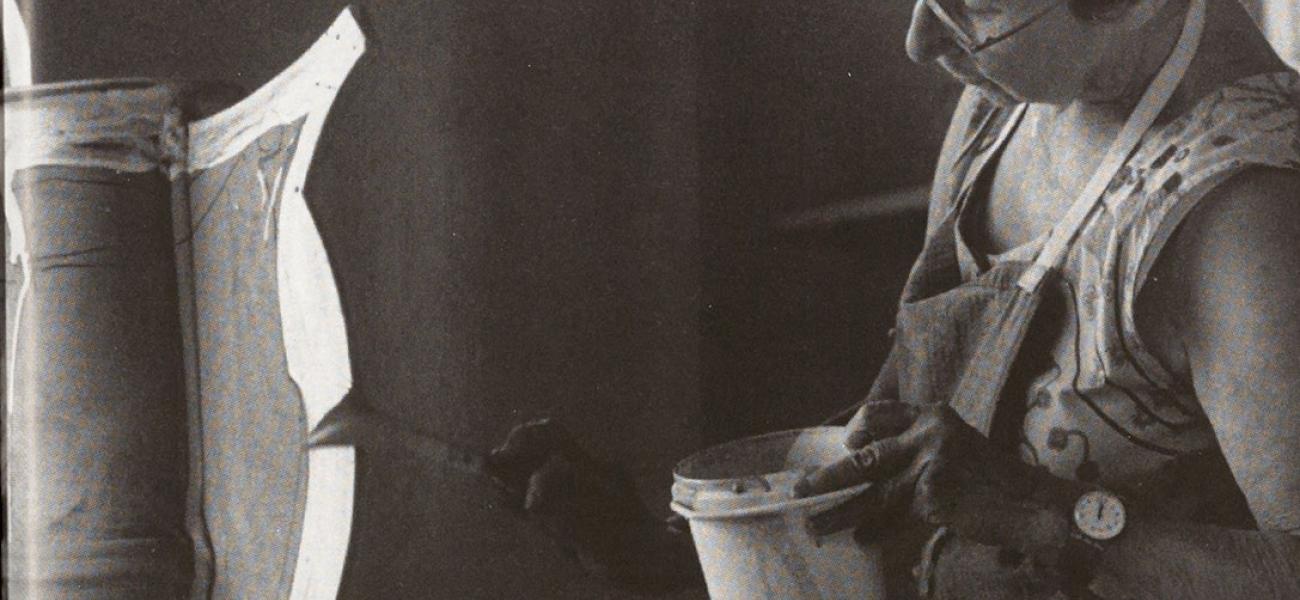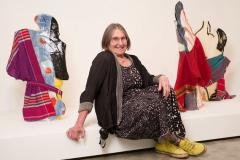The Painted Garden
Betty Woodman: An Interview
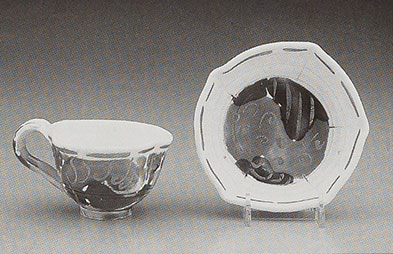
I applied for and received a Fulbright scholarship in 1965-66, and George a Faculty Fellowship. We went to Italy for a year, and lived just outside Florence on the grounds of a villa. I was determined to set up my own studio and make stoneware pots, and to build a soft brick kiln fired with propane.
I had first gone to Italy by myself in 1951 and spent a year there. Subsequently George and I were married and had two children. I had such a wonderful experience in Italy that year that I hoped to go back some day. So we saved our money and returned to Italy in 1960. At the time, George was teaching at the University of Colorado. In Italy, I worked with Giorgio Ferrero, a painter who had a ceramics studio. It was a wonderful year for all of us.
Now in 1965 it was my plan to have Giorgio come and work with me and experience what stoneware was. I had a hard time finding any stoneware clay in Italy. There were no such things as ceramic supply houses. Eventually, after a great deal of research, I went to the town of La Bourne in France where there was a stoneware tradition and a wonderful clay. This involved leaving George with the two children and going off on the train to Paris, then taking another train to a market town where I could get a bus to La Bourne.
I had written the mayor to ask whom I should see, but when I arrived at the village I found a sign that listed all the potters in the area. It turned out there was no clay supply house where they would either sell or give me clay, and when I phoned some people I found they would send me nothing less than a freight car load of clay.
Nancy Graves and Richard Serra were in Florence also. Nancy had received a Fulbright to Paris the previous year, and they needed to pick up their possessions. So I rented a truck which they drove to get to Paris to pick up their trunks and went on to pick up some clay for me. They returned to Florence and left the clay off at our place. This was before the invention of plastic sheeting and by the time the clay arrived it was hard -120 hard blocks of clay!
It so happened that Wayne and Donna Higby had recently been married and were visiting us on their honeymoon. Wayne and I surveyed the stiff clay. We stayed up all night poking holes in it with a broomstick and pouring water into the holes. It didn't help, but I eventually found a place where I took the clay and had it mixed up.
It embarrassed me that I had made a huge fuss to get the stoneware clay. This was April and my Fulbright was up in June. I had a mountain of clay and felt I had to use it up and make it disappear. I worked very hard and made a lot of pots. In the process, my work became looser and looser. The pots I made were related to Etruscan pots and had a direct relationship to drawings I had made of pots in the Archaeological Museum in Florence. The pots were made in sections and put together freely. I made handles that were sections of thrown clay. That body of work became a collaboration with George, who did the decoration. In 1992 Andrea Miller Keller showed a group of them in my show at the Wadsworth Atheneum in Hartford, Connecticut.
We fired the pots in the gas kiln. In the reduction firing, the clay bloated and did all kinds of wonderful things, which made them seem even less refined. It was an interesting body of work. In the process of making them, I woke up to the fact of why I was in Italy, and asked myself why I was struggling with a clay that was not native to the place. Why not use the materials that were at my doorstep, literally under my feet? And that is how I came to use the earthenware clay from Montelupo.
EARLY LIFE
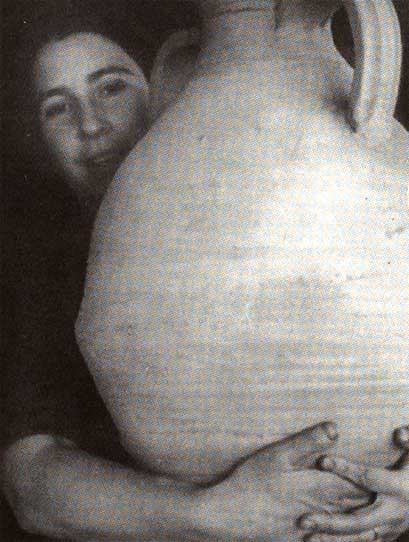
My mother worked for many years as a secretary for the Associated Jewish Philanthropies in Boston. She also was the secretary to the president of Brandeis University for the first five years of its existence. It was an exciting and interesting job, to be in on the formation of the University. From my mother I got a sense of approval to work and a passionate interest and involvement in what I was doing as a woman, that it wasn't just enough to stay at home for the family, that it was fine to have a career. Both parents were open and interested in seeing that my sister Dorothy and I each had a way of making a living, that it was important to be independent. They were not conventional thinkers.
We had very little money. This was soon after the Depression, and whenever my father got a raise we would move to some place a little nicer. We started off in Boston living in Allston, then moved to Brighton, then to Brookline, then to Newton. Moving was something they were used to, and I had to make new friends as an accepted part of my life.
I really liked the arts and thought seriously about them. From the third grade on I did a lot of home economics in school. When we moved to Newton I was in junior high and, rather than take yet another cooking course, I petitioned the school to be allowed to take woodworking with the boys, and was the first girl allowed to do so. One of the reasons I wanted to do it was that my father was doing woodworking. I made a window box and learned to turn bowls on a lathe. We also made model airplanes for air wardens to identify during the war. I made a Messerschmitt, but when my interest in identifying war planes waned I made a Dutch sea plane because it was prettier and had pontoons. Aesthetics took over and practicality left, and that's the beginning of my career.
While I was in high school my art teacher went to Cranbrook's summer school one summer in order to improve herself and get a raise. Upon her return she talked our school into letting her teach a pottery class. We had no equipment but were given a room in the attic of the building. We coiled pots. I made a pitcher and painted the glaze on. We took our pieces to be fired down to a garage in the wholesale fruit district of Boston. I remember the pitcher had a sort of rusty-looking glaze which came out of the kiln green and black and spotty. It seemed like magic. That was it, as far as I was concerned. I wanted to be a potter.
Miss Miles, the teacher, was excited about my decision. She helped me research where I might go to study pottery after high school. My parents wanted me to go to Black Mountain College, or to Antioch, because of the practical work experience along with theoretical. My father thought my sister and I should become teachers, a field a woman could make a living in. But he never objected to my being a potter. Coincidentally, our son Charlie graduated from Antioch!
The school career office helped students find schools. We came up with N.Y. State College of Ceramics, which taught industrial ceramic design. My teacher and I stewed over that. She said, You don't want to be an industrial designer. I had gone to a commercial art school in Boston for one semester, but I really didn't want to be a commercial artist, although I was aware I had to make a living. I wanted to be a potter. So Miss Miles found the School for American Craftsmen at Alfred University, and we both decided that was what I wanted. The School for American Craftsmen, founded by Mrs. Vanderbilt Webb, was originally at Dartmouth College in New Hampshire, but when the school started accepting women Dartmouth wasn't comfortable with that and they were persuaded to move the School to Alfred, New York, as part of its liberal arts college.
The first thing I did after I applied to the school was to get on a bus and travel down to New York City for an interview with Mrs. Webb. Mrs. Webb was warm and welcoming and accepted me for the school. I guess the interview was about how committed I was and what I wanted to do. I was one of the younger students. Many students were war veterans.
At the School for American Craftsmen, patterned after an apprenticeship, you were expected to go to school for two years and work forty hours a week, fifty weeks a year. There were fifty faculty and students in all. Each discipline had two faculty members who were producing craftspeople, not just teachers. Students were
not given a degree, and were not qualified to teach school, but were trained to go out and make a living as a craftsperson.
It might help to clarify this by understanding the geographical layout. Alfred, New York, is a town which in 1948 had a population of 700. It contained three colleges: the N.Y. State College of Ceramics, offering degrees in Industrial Ceramic Design and Ceramic Engineering, plus master degrees; the New York State College of Agriculture; and Alfred University, a private liberal arts college. The School for American Craftsmen was part of Alfred University for three years of its existence, then moved on to Rochester, All referred to as "Alfred."
The School for American Craftsmen was way ahead of its time. It was an interesting and experimental place. Lynn Phelan and Olin Russum were my teachers. Frances Wright Carroway, Frank Lloyd Wright's daughter, taught marketing. Later she moved to be the head of America House in New York City, all part of Mrs. Webb's umbrella. Mrs. Webb was a remarkable visionary. We all owe a great deal to her.
I learned a tremendous amount at the school. I received a "journeyman's certificate," and my graduating journeyman piece was a punch bowl with 24 cups. During the two years, when one was skilled enough, one presented a production item which was in turn sold through America House in New York City. My first production item was a custard cup, a perfectly good production item. I still have all the records on how we figured out how much it cost to produce. There was a set of six: two green, two blue, and two yellow. They sold for $1.50 at America House, of which I received .35 cents. The shop received .75 cents, and .40 cents went to the school produc-tion costs such as overhead, clay, materials, firing, etc. One was supposed to keep a record of how many minutes were spent, for instance, wedging the clay for each cup. This discipline has stayed with me, and I still feel that if I go from a to b, it mustn't be this way but that way.
The final marketing lesson from Mrs. Carroway was that we received one dollar an hour for our time. We were taught that when we were skilled enough we could produce twice as many pieces, getting two dollars an hour, then a very good wage. What was assumed was that you could sell twice as many pieces and, of course, that's not necessarily true. Her idiosyncratic advice to us on pricing on our last day was to go around and check on what other things are priced at, see what the market will bear, then price our work!
For me, it was a wonderful education. I adored it. It was not easy for me to learn to make pots. Some people throw easily, but for me it was a terrible struggle. I used to come home after class to the old barn at Alfred where I lived in a cooperative dorm and just peel off my clothes. (I think I threw more with my bosom than anything else.) I had to work so hard to learn how to do it, but it was really what I wanted to do.
The practical aspect of the school was most interesting to me. It was important that it wasn't just abstract but that I was really learning how to do something. It was also appealing to me from a social sense, that I would be a potter and serve society in some way. Using beautiful handmade things would make people better. I still believe that. My work can have a social value in that having beautiful things around can remind people that the world is more than ugliness and violence.
It was an interesting social time, too. I was on the East Coast, where the aesthetics looked toward Japan and the Orient. When I was going to the school, Bernard Leach came to the United States for the first time and lectured at the Boston Fine Arts Museum. Then he traveled up to Alfred and taught. We had his book, our bible, the only real book, even though there were some technical books available, too. We read his chapter "Towards a Standard," and analyzed it and worried over it. There were sixteen of us in ceramics, eight the first year and eight the second year. Our teachers, Mr. Phelan and Mr. Russum came from very different backgrounds and were not always in agreement aesthetically. I think my strongest influence was from Mr. Phelan. His attitude was, Try it and see. No matter what he was asked, that was usually his answer. He threw everything on the wheel, but then manipulated and decorated the forms. I think, however, I learned as much from my fellow students as from the teachers. It was a very open school.
Upon finishing the school, I returned to Boston and moved in with my parents. I had been taught how to set up a studio, and how much money it would cost, but I didn't have any money. So I worked in Cambridge for a potter named Barbara Ladd. She said I could come and share studio space in return for helping her. She paid me $5.00 a week, but since that wasn't enough even for my car fare, she said I could teach an evening class. I was lucky. My future husband George Woodman was in my class, as was my mother.
George was a freshman at Harvard. He had considered himself a painter at Exeter where he went to prep school. His painting teacher's wife had been interested in ceramics, so he came to Barbara Ladd's studio to learn ceramics, and was put into my class. My mother also enrolled in my class because she felt she might understand me better if she did some ceramics. I think it was wonderful that she did. George didn't really like to get his hands dirty, so he sort of gave up. I don't think I was really interested in teaching George, but was more interested in other things about him. I'd never taught before and wasn't very judgmental about what was a good student. I didn't teach there for long, deciding this was no way to spend my life.
ITALY AND NEW HAMPSHIRE
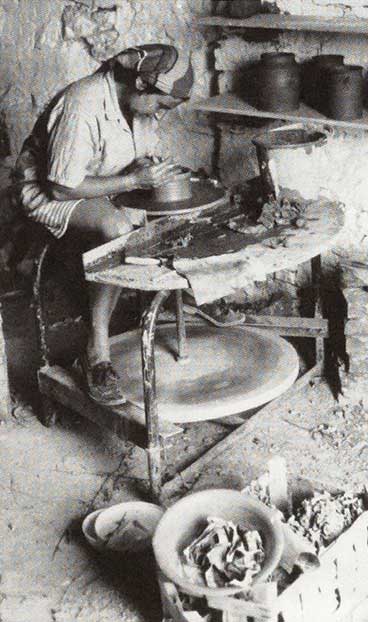
It was an interesting moment in Italy, just after the war. There was a resurgence of life, and it was wonderful for me. It taught me to love Italy and exposed me to a tradition of ceramics that was very broad and that no one was particularly aware of because everyone I knew was looking at Leach and to the Orient for inspiration. I looked around Italy instead. So much of Italy is clay - roof tiles, big flower pots, the inclusion of ceramics into architecture and within landscape architecture. The Etruscan pots particularly interested me, as did Roman pots. Then, of course, there was the tradition of majolica, which eventually led me back to looking at Hispano-Moresque work. I didn't get much of this in school, or wasn't aware of it.
When I returned from Italy, I moved back to New Hampshire for the summer as an au pair in exchange for a place where I could live and build a kiln. David Campbell, the director of the League of New Hampshire Craftsmen, came to visit me. He took me seriously. It can be very important to have someone take you seriously. There are many moments in one's life when you might continue with something, or drop it. Having somebody else come in and say, this is interesting and worthwhile, can be enough to make you feel it is important.
I had been influenced by Frans Wildenhain, who came to teach at the Craft School after I left. The Bauhaus aesthetic he represented was important to me. I visited the Bauhaus Museum in Berlin a few years ago and was fascinated by the pots there. It became clear to me that what I had been trying to emulate in 1948 was the Bauhaus aesthetic in ceramics. That was what I had been trying to do - make that teapot, have that thin edge, that kind of handle. I was not trying to make an Oriental tea bowl, but a European cup and saucer. I had bought the Leach aesthetic in many ways, but not in others. The aesthetic of someone like Marguerite and Frans Wildenhain was something I aspired to. It's still embedded in me, and comes peeking out occasionally.
There are many potters working now who are around my age. Most of the men came to pottery at an older age than I, such as Ken Ferguson, because they were in the army. I think the person who came to it the same time as I was Karen Karnes, who had been at Alfred before I was. David Weinrib and Karen were married. They were important names then, and an echo of their names is still audible in Alfred. They went to the New York State College of Ceramics, which had a different aesthetic. I was a potter. I had no intentions of being an artist. I was really just going to be a potter. The Ceramic College wasn't about being a potter. Their idea of giving something to mankind was to design for industry. The graduate students were the ones who were artists. The graduate program was about being artists,
with leanings toward design. We, however, were working by hand.
There were big arguments while I was there as to whether you could make pots faster and more efficiently by casting or by throwing. We were taught that if you threw pots you could actually make them faster. They were taught to produce ware by making molds.
MARRIAGE
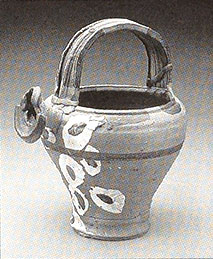
George was a painter and had gone to Harvard because his father suggested he should go there. However, there was no painting at Harvard. His father should have told him to go to Yale, where he could have studied with Josef Albers, but then we would never have met. I'm grateful to his father for that, even though his family opposed our marriage. George majored in philosophy since there was no art at Harvard. Philosophy was an interesting background for him as a human being and as an artist.
George decided to go to graduate school and study painting. He applied to Yale but they wouldn't give him credit for his degree with honors from Harvard, and would only accept him as a freshman. He did have an interview with Professor Albers, who told him that the other students would know he had a different background, and that he wanted to take his students and form them completely.
George and I looked at each other. Let's get out of New England, we said. We had been to Mexico for our honeymoon and thought that New Mexico would be like that, so George applied for graduate school in New Mexico and was accepted. We got into our green Jeepster and drove all the way to Albuquerque.
I was pregnant at the time, and I rented a little store front and set up a studio, where the first lesson I learned was that wet pots freeze. All my pots cracked overnight. George built our first kiln out of adobe bricks with a red brick liner, it cost fourteen dollars. It was a woodfired bottle kiln, following Bernard Leach's plans on how to build a kiln. We bought beachwagon-loads of pine scraps for one dollar a load from a molding factory nearby. I dug all my own clay and worked at cone 01 making decorated functional pots. I was very interested in Native American pots, and we started acquiring them, but I didn't try to emulate them in my work. I knew they were too close, and you always need a little distance from what you admire. I tried to make things that were inspired by Hispano-Moresque pots in the wood kiln, and made lustres by reducing the kiln as it cooled.
In my second year in Albuquerque, I had a studio partner, Elenita Brown. We called ourselves Roadrunner Pottery. I was doing majolica, decorating on the surface with stripes. I was interested in decoration but not skilled at copying things. It's been my good fortune that I wasn't very skilled. Maybe if you're less skilled, you just do what you can do. We sold pots wholesale to stores, as I was taught to do. I think when we figured out how much money we made after all our expenses, it was fifty cents an hour, not a great wage but it was as good a wage as at the only other job I could get, which was filing books in the university library. I did that for a week but when I had to wait in line for my lousy fifty cents an hour, it was too much, and I quit.
George applied for teaching jobs and was accepted at the University of Colorado. We moved to Boulder and rented a farm house outside of town, where I set up a studio and started making pots. Instead of digging my own clay, I went to a brickyard in Denver and simply got clay from the brickyard. I took boxes down and they filled them up. I mixed the clay wet as a slip and sieved it through a window screen and dried it on plaster bats. It was very nice red clay, even if labor intensive, and I fired to cone 01.
This was a time when in order to be a real potter you had to work in stoneware and be one of the boys. And they were all boys. At that point, I met Jim and Nan McKinnell, and later Paul Soldner as well. These people are so important to a great many people. They are important as artists but are equally important as people in the field, because what they have done changes the way we work and use clay.
Jim McKinnell had designed a kiln, and had a blueprint which he sold for the kiln. We bought the blueprint and built his kiln. It was a soft-brick, top-loading kiln. The top-loading kiln had stainless steel rods running through drilled holes in the brick. We got the burners from someone he recommended. It was a wonderful kiln. I used that kiln and made a lot of pots. At last I was starting to work in stoneware and be a real potter, and not just a hobby-lady doing pottery.
In Boulder there was no place to sell my work. Just nothing. So I started something which turned out to be a very good thing for me. That was a Christmas sale. This may sound like the most ordinary idea in the world, but at that point nobody else was doing it. I started having sales once a year, sending out announcements and inviting people to the show. The first one we ever had was during a horrible wind storm. The metal shingles blew off the roof. I made $250. We bought a couch for the living room. Afterwards, people started coming every year to my sales and buying pots.
I had a sale in Boulder for many years. Sometimes with a friend at her house, sometimes at mine. Then I started doing a second one in the Spring when I could hold it outdoors. I made a lot of flowerpots, hanging ones and wall pots. I built up a loyal following of people who would came to the sales. After the sale I got stores to buy my pots wholesale. I was surviving financially. George and I have always worked to make a living because you don't make much money teaching. For many years George decorated most of my pots. I made the pots and he decorated them. He built the kiln and I fired the pots.
In 1957, our second year in Boulder, in addition to making pots, I started teaching in the City of BouIder Recreational Department. I started with one class of seven students, and when I retired in 1972 there were 400 students taking pottery classes every eight weeks.
It was my program and I developed it, but I also hired others to teach. We taught children from age four to people in their eighties. The philosophy of the program was that the adult classes were split into beginning, intermediate and advanced levels. A person began in the beginning, then moved toward advanced, and they could only stay in advanced for three quarters, then they had to leave. They couldn't stay there and do their own work. This was not an open studio but really a class to learn something.
Students bemoaned the fact that they weren't allowed to stay, so I suggested they form a co-op studio, obviously a lot cheaper than if everybody bought their own equipment. They could share a kiln. That was the beginning of the Boulder Potters' Guild, and it's still thriving.
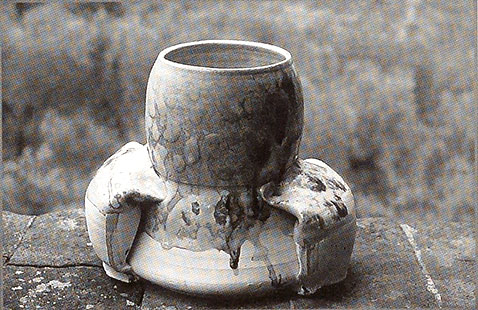
I frequently think about this, particularly with women. The justification of selling is very strong, and that if you can sell it, then it's worth doing, and if you can't, it isn't. This is true of the world of craft and ceramics, but not necessarily of the world of painting and sculpture.
Obviously, if someone wants what you make, it gives you sense of support. There is the feeling that if there is something you can't sell, it isn't any good. I don't believe that. The best things don't necessarily sell. Often, quite cynically, you find that the worst things sell.
NEW YORK
Twenty years ago we came to New York for a semester to try it out. There was a pattern and decoration movement that seemed to be going on here. George was involved deeply with that for fifteen years in his paintings, but because he was in Colorado he wasn't a part of it and wasn't known.
We were both showing with Nicholas Rodriguez of the Hadler/Rodriguez Gallery on 20th Street in New York. After our semester in New York, George and I went back to Colorado and thought about being in New York. It was very exciting to be there because it offers a lot to artists and to everybody, good things as well as bad. We decided to evaluate what this experience was, and not just be seduced by New York. We were approaching
middle age and, instead of comfortably settling in to the known and easy-to-handle life of Colorado, thought to do something with ourselves that would not be easy or comfortable, but might be more interesting. New York it was!
We had the good luck to be thinking of doing this at the moment when it was not financially impossible to buy a loft in New York. Lofts were cheap. I was teaching one semester a year at the University of Colorado, George could teach one semester a year, and so we had a full salary between the two of us. Our kids were pretty much grown up. Francesca was at art school, Charlie in Santa Fe making films. We could manage it also because George sold his studio in Colorado, and that was the basis for buying this place.
We bought a loft, a floor in a former manufacturing building on 17th Street in the Chelsea district. People bought floors and converted them into what was called "live/work space." There are 3,000 square feet inside our loft, 40 by 80 feet in dimension. We hired an architect and she came up with a plan on how we might divide the space into two large studio spaces, with a storage space between them. The living space was small but we made do with it. We also knew we would want somebody else to stay here when we went away, so we divided it for a sublet when we went back to Colorado to teach.
Now in my New York studio I have a small portable Soldner electric wheel, like the one I had in Colorado and in Italy. I have two large work tables on which I assemble pieces. I put parts on them when I'm throwing parts. I put glazed pieces on them and look at them. One is covered with canvas and the other has a painted surface. I'm very short so they are the right height.
I have wall surfaces and floor surfaces. Since much of my work is done on the wall, I resurfaced the walls with a layer of plywood so I can put nails into it and it will hold when I try out pieces or assemble work. In addition to the storage space between our two studios, I also rent storage space in a sub-basement in an old building on Eighth Avenue, and in Omaha, Nebraska where we have long-term storage space and archives. It's a problem what to do with alI your work. If my studio becomes too full of work, it inhibits me and I think why do I bother doing more. Storage is part of the economic structure of our lives.
I have a front-loading electric kiln, about 40" high inside, made of fiber and very efficient in its use of electricity. It's a Carol Suzzane kiln from California. It is in a separate room with an exhaust fan. The kiln has a 10" vent at the top which I leave open until it reaches 1,000° F, then close to complete the firing.
My gallery in New York is Max Protetch on 22nd Street. New York is a great center for art. We have many friends who are artists, not necessarily all ceramic artists. We live here, we meet people, we see them again, exchange studio visits, and have things in common with them. When we moved to New York, we already had a base of friends in New York who were artists because for many years the University of Colorado had an active visiting artist program in which we participated and through which we made many friends.
Now we have retired from teaching at the University of Colorado, where George taught for forty years and I taught for twenty years. Essentially we live half the year in New York and the other time in Italy.
I T A L Y
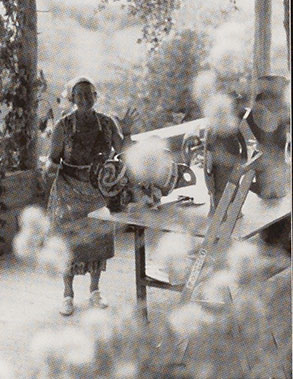
In 1966 George had received an National Endowment for the Arts fellowship for $5,000. The money was sitting in the bank. We decided, why not? We began looking for a house in good condition that wouldn't put us in over our heads. Eventually we found such a house above a town called Antella, just outside Florence. It had a good roof and potable water. We paid $8,000 for it in 1967.
We live ten miles from the cathedral of Florence and can see all of Florence from our house. That was important to us. We were not living in New York then, but in Colorado, and one of the things we liked about the prospect of living in Florence was how intensely urban it was. We wanted to be in the country where I could build a kiln, but very close to the city where we could have a city experience. George and I really just stumbled onto the house. It was inexpensive, we liked Italy and hated going home. I don't think we really thought about what it would mean. In some ways, George and I have had the good fortune of not thinking everything all the way through. If you think everything all the way through, sometimes you won't do much.
Here we are a part of a cluster of houses on two and a half acres, with 160 olive trees that spread down the hill. The farm house is essentially on three levels. The cows once lived downstairs, and the farmers upstairs. The bottom level, which used to be the wine cellar, is now my studio. There is a big room called orciaia, where big jars of olive oil (orci,) were stored, and that became George's pensatoio or "thinking room." He also has a studio above the wine cellar.
Of course this changed our lives. At first we went to Italy every summer. When we reached Italy we left the problems of teaching at the university behind. And after about three days, it was hard even to imagine that the university existed. It was a real shift for me to adjust to another studio. As a production potter in Colorado I didn't have a line of production work separate from what I called art. Everything I did I considered the same, in a sense, though I produced a lot of pots. I have always used different kinds of clay and different temperatures of working as a device for changing my work. I became interested in lead glazes because it's a wonderful and easy material for potters everywhere to use. There are uses for lead glazes, of course, where they are not inherently dangerous.
In Italy I became aware of a tradition that few people in the United States seem to know of or be interested in. And that is what I call the Mediterranean tradition of ceramics, a lowfire tradition, everything from majolica to flower pots. I don't think I assimilated it all immediately. Originally, I built a catenary arch kiln outside and down the hill from my studio. At that point I had become friendly with Paul Soldner and interested in experimenting with kiln construction. I thought it amusing to do a catenary kiln that didn't have any metal around it for support.
When I first started to fire this kiln, I used a blower. Paul used to buy old vacuum cleaners and turn them around as blowers. But there weren't any vacuum cleaners in Italy then that were first hand, let alone second hand. I finally found one in a pawn shop with wooden parts; I still have it because I'm sure it'll be worth a lot of money and eventually will pay for my retirement. We tried it, dragging an electric line down the hill from the house for its use. It was alI rather stupid and probably dangerous.
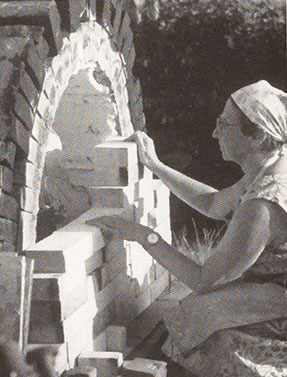
The kerosene came in 20-liter plastic containers. I had to carry the kerosene containers to place them up the hill for use. George wired a piece of garden hose with a goose-neck and lever to let the kerosene flow out. It had to go very slowly. The kerosene had dirt in it that was always plugging up the line. I would sit beside the kiln and watch it belch great billows of smoke. I fired this kiln that way for probably twenty years.
For the first few years, I tried to fire it without reduction, and labored mightily over that. I started the firing with a propane burner to warm the kiln up, so it wouldn't be quite so dangerous when I started putting the raw kerosene inside. I looked at some of the pieces that came from the kiln and, where they were reduced, they were really quite beautiful.
I realized I should go for the reduction. The greatest reduction in the kiln was at what Leach called the "cherry red stage," probably about cone 017.
But I was trying to understand what the kiln was doing instead of making it do what I wanted it to do so I sort of went with it. That meant that the body was being reduced before the glaze started to melt. By reducing the body before the glaze had melted and sealed, I would get a beautiful celadon gray. If I was careful to oxidize at the end, at cone 08, then I could watch the glaze develop until it was smooth like molasses before turning the kiln off. There were flashing places of red where a little air reached it, oxidizing the iron in the clay into wonderful spots. The pieces I was making were rather small scale vases. I decorated by applying thick wet slip with a pastry tube onto the wet clay. The slip applied through the tube had a fair amount of air in it and would occasionally re-oxidize during the firing.
I pursued this method in Italy for many years. I made very different kinds of pieces in Italy from what I made in America. I didn't try to make functional pieces, although I made things for us to eat out of. I wasn't trying to sell pots in Italy. I was trying to use my time there to experiment with ideas, and not just make pots, to stop and think and work in a slower way and to try different things, the kind of things when you're working hard in your studio you don't always have the time to do.
Essentially, we lived in Italy part of each year for thirty years. Now I'm at home in both places. I'm not a tourist in Italy, nor a visitor. I simply have a unique relationship. Or perhaps you could say I'm not at home in any place. When you're not really a resident anywhere, you can avoid some social responsibilities.
In the 1980s came the movement against Euro-centric ideas, strongly articulated by my colleagues teaching in Colorado. In 1990, when I went to work at the European Ceramic Work Center, I woke up the first night in my bedroom shouting, well, I am Euro-centric, I do live here, it's part of my culture. I think I have been profoundly changed in that way. Because I live abroad I also realize how American I really am, how I have an understanding of what it really is to be an American. It's simply a matter of living with two cultures. This has come up a great deal in terms of our daughter Francesca's photographs. She lived a great deal of her life in Europe and had a European feeling and sensibility. And is seen in our son Charlie's video installations; the one which opens shortly and is called "I Morti!"
Now we have the best (and the worst) of both worlds. New York is very interesting, very intense, very difficult, very involving in terms of being an artist. I feel I exist as an artist in this rich, beautiful culture. There's just so much going on. Also an exchange in terms of contemporary work. One may not like what's happening, but I know what's happening, and I'm interested in it and feel part of it.
Then I go from New York to Italy, and don't see anything happening in terms of contemporary art. But in Florence I live with the Renaissance. I have visual experiences. The Renaissance is visually all around me, and that's important for me because I'm a visual person. What I'm looking at is the period between the 14th and 17th centuries, an amazing time in the history of art.
CURRENT WORK
There is a certain history to my work. It started when we moved to New Mexico and built a woodfiring kiln to make functional earthenware pots because the available clay was earthenware. Then I became involved with the technical aspects of stoneware, and having to figure out what stoneware clay to use. Later I became curious about salt glaze, probably in 1960 before I built my first salt kiln, with no one telling me how to do it, but just reading about it and pursuing it.
When I returned from the Fulbright in Italy in 1966, I tore down my first soft brick kiln because it was deteriorating and built a second salt kiln. I decided what I really wanted to do was make big pots that related to those pots which I had made during the Fulbright, but to salt fire them. I built a kiln with a big floor, because the previous kiln gave me a lot of trouble with shelves.
I made a lot of big (for me, 30 inches tall) salt glaze pieces, with a great deal of interest in Roman and Etruscan pots, and an interest for the first time in Oriental pots. I also looked at bronze bell forms at the Metropolitan Museum of Art in New York, working from the point of view of a culture totally different from that of salt glaze. I was doing salt glazing, but not looking at German beer steins or that salt glaze tradition. Taking one tradition in terms of materials and mixing it with a totally different tradition with its forms, and trying to put them together·. The business of marrying things, with layers of references, has been with me for a long time.
The present direction in my work started in Italy, when I decided I had just better stick to earthenware. This was due partly because of a fuel shortage and since we couldn't get kerosene, firing to cone 08 took a lot less fuel than firing to cone 10. It also had to do with George and me deciding he wasn't going to decorate my pieces any more. Previously, all of my salt glaze pieces had been a collaboration with George who decorated my forms.
I could visualize myself in the strange position of making bad imitations of George's work. So the next time I went to Italy, I decided to do earthenware. I started decorating the earthenware pieces myself, and that became satisfying, challenging and very interesting.
Now that we live in New York and don't have studios in Colorado, I have abandoned salt glaze. My life is simpler in terms of materials and firing temperature. I've branched out into other media; I've done pieces in bronze, and I make a lot of prints and drawings.
A VASE AND A SHADOW
My work is all made on the wheel. Essentially, I create clay on the wheel as the fabric, then cut it and piece it together. I don't use a slab roller and don't often build things with coils.
I started making wall pieces after I visited Nino Caruso's studio in Italy. He had a wonderful piece on the wall, a ceramic shelf with a piece sitting on top of it. I looked at that shelf and said, wow, that's pretty great! So I decided that I would make a shelf that would be on the wall and make a vase for the top of the shelf. That was the beginning of this series.
Once, in an older form, I had designed shelves made out of wood with a vase triptych sitting on top, quite baroque. Each shelf was specific to the piece, sort of a reflection. But people were hostile toward the idea of my using a material other than clay, so I abandoned the wooden shelf. When I saw that piece by Nino, I thought, well, I'll try a clay shelf. The handles of the vase became detached from the vase and attached to the wall behind it. I don't know what prompted me to do it. Sometimes you do a thing and don't know why.
I made a piece called A Vase and Shadow, which came about through an experience with a student with whom I was doing a critique. The young man had a long face and looked very unhappy. I walked in to where he had his piece on the floor, and part of it was leaning on the wall. He said, Look, it came off in the firing and is a disaster, and all my work is a mess. I looked at this thing leaning on the wall and thought, That's great! So that's where my Vase and Shadow came from. This piece was pivotal in the development of all my recent pieces.
I think I became interested in the handles, and in some way seeing how they looked like something else, being aware of the space around them, putting a group of them on the wall as an installation. I had a show of six simple pieces filling a wall in a museum. Suddenly I saw them not as six pieces but as one piece. There was a unique interaction.
BALUSTRADE VASES
I started working like that; my next pieces came directly out of that show. I went to Italy and started working and made the first pieces of this kind. I call them Balustrade Vases. In terms of sculpture, I call them reliefs. The balustrade has always interested me because the actual form of a balustrade produces a shape between the columns. You see a balustrade where the negative space might appear to be a pot. It's almost like playing with the figure/ground relationship. Which is real? The space between or the actual object? Sometimes the space between is a pot, and the object a funny, almost abstract thing. They come out of space but are attached to the walI, are not freestanding sculpture.
EARTHENWARE
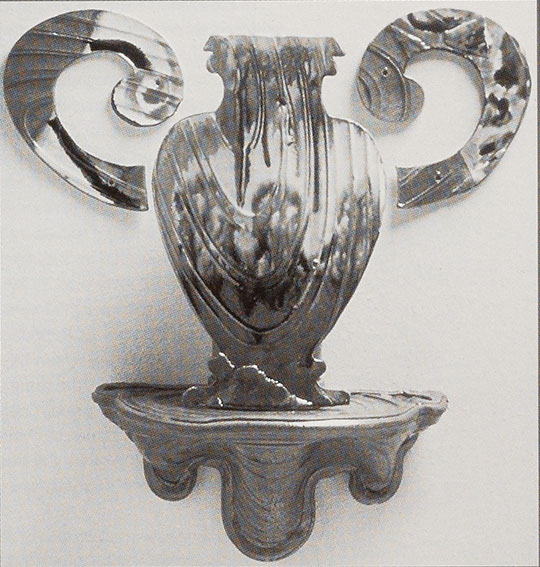
I developed a body that is one third ball clay, one third kaolin, and a third fireclay, with some grog, sand or molochite to give it some tooth, plus some flux to tighten it. Actually, I developed this body while teaching at Scripps College and have used this clay with variations ever since.
Let me describe my current wall forms with
fragmented pieces. First, the clay is wedged and thrown on the wheel. I make a rudimentary disk, depending on how much I plan to stretch it, maybe an inch to an inch-and-a-half thick by 12 inches in diameter. With my finger moving across the wheel, I make a spiral. Then I throw this clay onto a piece of canvas attached to a board, and I stretch the clay. Depending on how soft the clay is, I may wait a while before continuing to stretch it.
I cut out shapes from the stretched spiral slab either by drawing directly on the clay or, most often, by drawing and cutting out a pattern from paper or stencil material. The spiral is left as a kind of counterpoint to whatever I do with the painting; it's my fingermark. Even smoothing out the clay with a rib leaves a memory of that rib mark as it's thrown. You have a sense of the clay as a skin; this is important to the piece. I don't use a slab roller because it would leave the mark of the canvas on the clay, which is not as pretty as the memory of your fingers on the wheel, or as romantic.
The wall pieces contain a vase, a three-dimensional, thrown form which I use in front of a flat piece, often as an image of the vase, somewhat fragmented. It depends on the way I use it as to which is the front and which the back. In a free-standing piece I don't differentiate. I call one part the front and one the back but I feel there are simply two views of the piece. One view may not have the three-dimensional piece, but when you see the other side, it does have it.
Usually I like to have the three-dimensional vase peeking through so that you become aware of it. It does two things, as my work often does. First, it has a practical purpose of holding the facade up and away from the wall. Second, even if you don't actually put flowers in it, you can think about putting flowers in, so the function of the piece becomes conceptually part of the work. It leaves me with the choice of sometimes putting flowers in it, which I'm very interested in. This depends on my mood; sometimes I reject the idea, sometimes I accept it, but it allows me to do that.
I have always used the technical aspect of clay as part of the aesthetic side of my work, as a way of changing and not just being repetitive. If I know what's going to come out of the kiln, if I change the method of firing, or I change the temperature or the color of the clay, the glaze, or the slip, then I have a whole new challenge to keep me from being bored. Ceramics is so rich technically that you can spend fifty years working with it and still find it exciting, because you don't quite know what you're going to do.
I make a vitreous slip to use either on bone dry clay or on biscuit clay. I have many colors, perhaps ten, in slips. Usually, in the kind of painting I do in the United States, I start by drawing on the biscuit piece with a marking pen before beginning the painting. If the color is to be green, I may decide to use orange as my ground color, then start with a green on top of that, a chrome green that's quite dark. It's different if the green goes on top of black or on top of orange. These slips are opaque. I can start with a dark color and go with a light color on top. That's exciting. A little of the under-coating peeks out here or there. The brush stroke gets thin and you read through it, making a richer surface. Everything has at least those two layers; sometimes there is a third layer.
It's quite a rich surface. On top of that I will use overglaze colors (I have about fifty). If I start with a black, place a chrome green on top of that, then come on top of that with, say, an overglaze stain of Victoria Green, a bright yellowy-green made with vanadium, it will take that chrome green and give it a little more life so it isn't just a dead green, because it has highlights of another color. I have learned technique from studying painting, using underpainting, assembling, a line to refine and define.
Then perhaps I'll decide that it needs a line to define it, that I don't want to work with color alone. The last thing then will be to use a black overglaze stain and draw on top to redefine and clarify. I don't use a sprayer; all these things are done with brushes.
I used to use Japanese bamboo brushes. I still use the kind of brushes that come in tandem so you can break them off to use, say, three or five. I use different brushes for different purposes. For a while I used flat Oriental brushes with soft bristles sewn in. The latest brushes I use are Italian. They are expensive, and seem indulgent, but I want to introduce the drawn line to my work and the Italian brush makes that line for you. I often tell my students, Don't be cheap. If you always decorate with the same brush it will have the same consistency. If you first pick a brush that's wide, and then go to a small brush, the work tends to have a richer look.
I don't think I really know anything about painting on canvas, but I think I do know a great deal about painting on a three-dimensional object. Spatially the form and the way you perceive it are very different. Even if it's a tile and a relatively flat surface, the way it is cut up makes a great difference in the way you read it. Segments change your perception.
In the United States I use one glaze and in Italy I use two glazes. I brush the glaze on, which is something I had to learn how to do because I had always dipped and poured my pieces. I brush the glaze on because the pieces are just too big to do otherwise. I use a lead glaze which is very forgiving. It doesn't become opaque but stays transparent. Even if you overlap, it doesn't matter. It doesn't have to be all the same thickness. In Italy I also use a fritted non-lead glaze.
I fire my biscuit kiln in oxidation to cone 08 or 07, and glaze to probably 03. The reason it's hard to to be exact is that New York doesn't have 220 volt electricity; it has 208. The electric kiln I bought came with an automatic shutoff. I questioned its use and I said to the supplier, You know, it's not going to work one day and I won't know what to do with it. I'd rather rely on myself; I've had so many students over-fire kilns in my life, and I know what that looks like. The man said, Fine, I'll take it off, but it will cost you $200. I said, Leave it on. It took me a long time to get used to using a pyrometer. You can go to the movies if you're firing an electric kiln because of the automatic shut-off. I fired the kiln a few times with cones and noticed where the pyrometer went, then set the automatic shutoff for that point. After fifteen years the thing did malfunction once and I couldn't turn it off, but Greg Pitts came over and puzzled it out for me.
I refire pieces, as I need to. I may refire them using a commercial glaze from Italy, firing probably a little hotter than the biscuit but lower than the glaze. If it needs some juicing up, I may use that glaze to give it something a little extra.
EUROPEAN CERAMICS
During the years 1956-96 in Boulder, Colorado, I worked in my studio in isolation. Studio potters were few and far between. At that time being known and existing within a political structure in the world of ceramics in the United States was based on a university connection. Painting and sculpting meant living in New York and showing in galleries. In ceramics it was: Did you teach at Alfred? Did you teach at Berkeley? Did you teach at Kansas City? I didn't teach, so I had no place in that structure.
I had a certain presence in America because of these things, and I started to be invited to be in shows. When I came to New York in 1978, Nicholas Rodriguez had started his gallery and asked me to have a show there; and that was an example of being in the right place in the right moment.
In Europe I had no presence. I had been in the international ceramics exhibition in Faenza, and had even received a gold medal for things I had made the year I had gotten the Fulbright, but this didn't really give me any presence.
Then I met Nino Caruso, the Italian ceramic artist and we became close friends. I introduced him to raku, which George and I were doing a great deal of in Italy. Nino wrote his books about ceramics in Italian, the first person to do so since the Piccolpasso book in the sixteenth century. The studio potter movement in Italy owes a great deal to Nino. He came to the United States and went to NCECA and couldn't believe what existed here. In Italy there were potters, and artists making pots, but there really wasn't anything going on.
Italy was not interested in what I was doing. Interest was in modern art and in ceramic sculpture, and that was not what I was doing. In Germany they were interested in a kind of minimal stoneware, and I wasn't doing that either. I was doing a baroque thing, and it just wasn't fitting in. People had no interest in me.
The interest came about very recently. Yvonne Joris, head of the museum in Akademie voor Kunst & Vormegeving, s'Hertogenbosch, The Netherlands, came to the United States with Evert van Stratton and curated a show for her museum called "Who's Afraid of American Clay?" She understood what I was doing, responded to it, and included me in the show. Then she asked for a retrospective of my work, to be held in 1990.
The retrospective show took place and produced a nice catalogue, a small hard-cover book that was distributed, and I think it somehow helped what I was doing. It also presented American clay. American clay was in a very different place from European clay. Europe wasn't ready to look at American work.
I think my work was very difficult for Europeans to appreciate because it came from a tradition with which they were familiar; they were too close to their folk tradition
and looked down on it. In Italy they all wanted to do stoneware. All the young people went to England and, when they came back, tried to drag their clay up to stoneware levels. What's further away always looks better.
It's changing a little now as they wake to what I do. My recognition in Holland, however, is big, and that fascinates me. I've had the two most important shows in my life in Holland. This is curious: I don't live there, so why are they interested in my work? Partly, I think, because they have a wonderful museum structure with a lot of money, and they are open to contemporary art and not hostile and negative about it. I find that remarkable in so small a country. Italy, on the other hand, is on the whole hostile to contemporary art. The government spends unbelievable amounts of money restoring and maintaining classical art. That's their patrimony. In Florence, one is overwhelmed by the Renaissance, but to be an artist in Italy is to get no support.
My show was organized by the Stedelijk Museum, Amsterdam and is traveling. It went to Portugal, to the Fundacao Calouste Gulbenkian, Lisbon. There is a lot of support money for contemporary art and for Portuguese artists in Portugal, but my show was controversial because clay is not a high art material. You might think it would be easier in Portugal, which has an unbelievably rich tradition of earthenware, and where it is part of everyone's daily life.
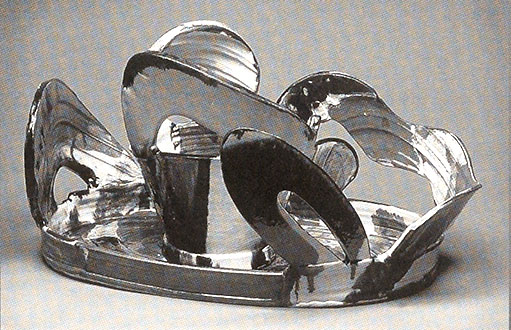
After all those years of living in Italy, the director of the International Museum of Ceramics in Faenza (to whom I had been sending announcements of my shows) came to a small group show. Faenza, from which "faience" takes its name, has been a pottery town for 600 years. The museum has an important collection of both historic and contemporary ceramics, and has sponsored a ceramic exhibition every year since World War II. The director said he should have a show of my work. I said, well, that's a really good idea. I told him the easiest thing to do was to have this big installation piece being shown at the Decorative Arts Museum in Paris come to Faenza, if he would pay for it to go back to the United States. (The last place it goes has to be responsible for sending it back to New York.) I said, If you will do that, the French will pay for the shipping to Italy. Which is the way it happened, so I had a show at Faenza.
In Japan, the Shigaraki Center had an inaugural exhibition. I received a phone call from a person in New York who was organizing the show, and people came and looked at my work. They wanted smaller pieces, not big installation pieces, and they purchased most of them for the exhibition. George and I decided this was our big chance to go to Japan, and we took the money and made the trip. I was invited to be in a show in Korea organized by a Korean potter who was a student at Bennington where I had had a show and given a workshop many years ago.
I owe thanks to the women's movement for awaking people's awareness. I was invited to be in a show last summer in Italy just because I was a woman. The curator wanted me simply because I was a woman, and she got into a huge fight with the other curator, who did not want my work because I was doing ceramics. I think he eventually came around. I like to feel that it is my work that is of interest beyond any other consideration.
A PAINTED GARDEN
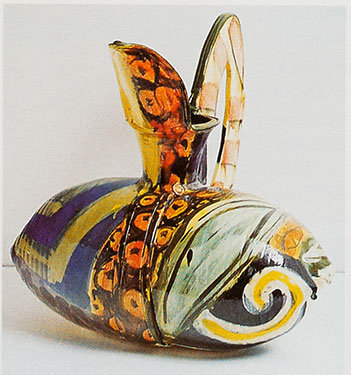
I wrote to the European Center and told them I needed a wall ten meters long. They were wonderful; in a few days I received their reply which said, Here's your wall. When I arrived I was given a great big studio and a big wall and frantically set to work. I made the piece in five weeks. I tested glazes. All my slips kept chipping off. And since they don't use lead, I had to figure other glazes out. They were very helpful.
The piece I made seemed to be about Roman wall painting, the kind you see in Pompeii or Herculneum. It's often true of my work that I do the work, then afterward it reminds me of something I've seen. It isn't that I see something and then do the work. The work comes first, then I'm reminded of something in the history of art, which I may then go and see.
The piece I did in Holland is called A Painted Carden ("II Giardino Dipinto"). It is a kind of wall relief, about space on a balcony looking out, or perhaps looking in. It's not quite clear where the viewer is in this piece. It has a balustrade, repeated elements, and a kind of organization. Once the piece was finished, George and I went by train to Naples, Italy, and for the first time visited the museum and looked at Roman painting. We went to Pompeii again, too. The piece is about paintings of architecture in architecture, about views of architecture, and always about pots because they are always around. They were and are there as part of architecture in Italy.
When the installation piece was finally on public display, quite a few people came to see it. George came for the opening. Most were interested and responsive. Some saw what I had seen in the piece, after it was done.
Pots were in Roman houses, and they are in the paintings. There are pots sitting along balconies. I've done other pieces from Roman paintings I've studied at the Met, using elements from them in my work. These pieces are, I think, very much about painting, about painters, about specific painters. I made a piece about a Japanese kimono. Another is about a painting of Picasso. Of course, it's very much before the fact, but I was inspired by Picasso's paintings, and have done pieces based on his specific paintings.
I was blown away by the Picasso show at the MOMA in New York and saw it many times. The museum has a program where artists are invited to come in on certain days when the museum is closed to the public and see the exhibitions without the usual crowds being present. Picasso's paintings were amazing, and I proceeded to do a series of pieces based on specific paintings. One of the reasons why I was so pleased to be invited to the show in Vallauris this summer was that I have a diptych piece that I didn't bring home from Italy because I thought maybe it was just too close to Picasso. (Is it awful? Is it good?) I just put it aside and left it in my studio there because I didn't know what to do with it. And now it's going to be in that show. I'm not interested, as an artist, in copying another artist, and Picasso would win if I tried to! What I am interested in is making a reference to a specific painting, much in the way that Picasso himself did. It is done in admiration, and as a way of contextualizing my work. It is a postmodern device, but it's certainly within the thinking of Picasso and what he did.
THE VESSEL AS ICON
The presence of the vessel in my work is often questioned. While the vessel may make the work seem conservative to the ceramic world, I think its presence can be viewed as avantgarde in the art world. The
introduction of function into the high-art canon is certainly not a foregone conclusion. Of course, it is easier to move from a "high" art position into "craft" than vice-versa. I don't make abstract art. I may paint abstractly, but I use subject matter.
The vessel is central to the history of ceramics. The history of ceramics has several veins. One is the figure, and that's been around as long as there has been clay. Another is the vessel, and that's essential to an understanding of what ceramics is. I continue to deal with the vessel. My vessel isn't functional any more, but it can be. It's about function and allows my work to be seen within the context of ceramic history. And in more ways these days, it's also about the history of painting.
If it's going to be about clay, then this is an important, if not essential, fact. I insist on it. The vessel has allowed me to be looked at and accepted in ways that I would not be if I had made a piece of abstract sculpture. If you make a piece of abstract sculpture, you're lined up with people making abstract sculpture, and the "why" of clay is indeed to be discussed. But there's no question in my work of the "why" of clay. I have my place in the discussion of art today because I do use the vessel. I'm not treading on someone else's toes.
I think I have recognition today partly because of this. Maybe it's partially because I've been smart enough to do it, or because I just do it. But I'm not making something called "ceramic sculpture." There is something that exists called ceramic sculpture, that is separate from sculpture, because it's made of clay. If you look at a Bernini sketch made of terra cotta, you don't call it ceramic sculpture; it's a sculpture made of terra cotta. You don't talk about a Bernini bronze or marble sculpture. You talk about his clay sculpture because that's the material he used. Ceramic sculpture seems to exist today as somehow different from other scuIpture.
Many critics are ready to talk about Woodman. Not all of them, of course, because I'm certainly not talked about by all of them, but I think there are critics ready to talk about my work. I think I have a place in the art world of New York, although I'm still a controversial figure, partly because of my work, which people either like or do not like. Some feel it does not fit into the general discourse, that I'm not making work about social issues.
I'm challenged by what I'm doing. I'm most interested in the piece in the kiln right now, and in the next piece I'm going to make. In that sense, I'm very happy with who I am. I may be discouraged by a piece I'm making but I'm very interested in what I do. Each piece I have made has led me to the next, as each step in my life has somehow led to the next. It was not a matter of planning and strategy. I've simply done what I enjoy doing and cannot help but do. I think a lot but I'm not an intellectual; I think as I'm working. But if I can't make pots at some point, I'll figure out another way to make art.
Betty Woodman
CV as published in 1998
SELECTED ONE-PERSON EXHIBITIONS
Exhibits with Max Protetch Gallery, New York, regularly since 1983
1996 Stedelijk Museum, Amsterdam, The Netherlands
Provincial Museum voor Moderne Kunst, Oostende, Belgium
Fundacao Calouste Gulbenkian, Lisbon, Portugal
Musee d'Art Contemporain, Dunkerque, France
1995 Denver Art Museum, Denver, CO
International Museum of Ceramics, Faenza, Italy
1994 Stedelijk Museum, Amsterdam, The Netherlands
Carin DelcoLll't van Krimpen Gallery, Amsterdam, The Netherlands
Musee des Arts Decoratifs, Paris, France
1992 Wadsworth Atheneum, Hartford, CT
1991 Lobby Project: Betty Woodman,Museum of Modern Art, New York
Betty Woodman: Works 111 Clay, Johnson County Community College
1990 Opera Selecta: The Work of Betty Woodman, Het Kruithuis Den Bosch, The Netherlands,
1988 Somewhere Between Naples and Denver, Denver Art Museum, Denver, CO Boulder Center for the Visual Arts, Boulder, CO
1985 The Ceramics of Betty Woodman, Freedman Gallery, Albright College, Reading, PA
1984 The Aspen Garden Room, Aspen Museum, Aspen, CO
Garth Clark Gallery, Los Angeles, CA
SELECTED PUBLIC COLLECTIONS
Boston Museum of Fine Arts, Boston, MA
The Brooklyn Museum of Art, New York
Cincinnati Art Museum, Cincinnati, OH
Cleveland Museum of Art, Cleveland OH
Denver Art Museum, Denver, CO
Het Kruithuis, s'Hertongenbosch, The Netherlands
International Ceramic Museum, Faenza, Italy
Joslyn Art Museum, Omaha, NE
Los Angeles County Museum of Art, Los Angeles, CA
Metropolitan Museum of Art, New York
The Museum of Modern Art, New York
Philadelphia Museum of Art, Philadelphia, PA
Rhode Island School of Design Art Museum, Providence, RI Stedelijk Museum, Amsterdam, The Netherlands
Wadsworth Atheneum, Ha1tford, CT,
The Victoria and Albert Museum, London, England
Whitney Museum of American Art, New York
Yale University Art Museum, New Haven, CT
Renwick Gallery, National Museum of American A1t, Washington DC
AWARDS
1995 Rockefeller Foundation Fellowship, Bellagio Study Center, Italy
1987 Governor's Award in the Arts, Colorado
1986 National Endowment for the Arts Fellowship
1980 National Endowment for the Arts, Craftsman's Fellowship
1966 Fulbright-Hays Scholarship to Florence, Italy

